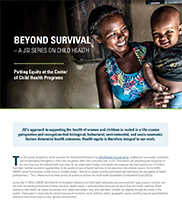The life-course perspective, which provides the theoretical framework for JSI’s Beyond Survival series, emphasizes how events, conditions, and circumstances throughout a child’s life can greatly affect their outcomes later in life. Child health and well-being are recognized to be more than just biomedical health outcomes. As we understand it today, child health encompasses the lived experiences of children, from their families’ economic opportunities to the quality of care at health facilities, to the education that children receive. As the WHO UNICEF-Lancet Commission on the future of children stated, “We can no longer consider child health and well-being the prerogative of health professionals.” Thus, efforts must be made across all sectors to achieve the child health Sustainable Development Goals (SDGs).
Across the 17 SDGs, UNICEF identified 44 child-related indicators, but child health advocates are concerned that large groups of children will not meet the minimum threshold of these indicators. Health equity is achieved when everyone can attain their full health potential. When looking at child health, an equity lens allows us to understand where, how, why, and which children are slipping through the cracks in the system. These gaps in equity may be present because of economic, social, political, and/or geographic causes, and they may be exacerbated by individual-level drivers such as race, gender, and education.


